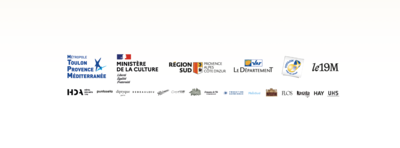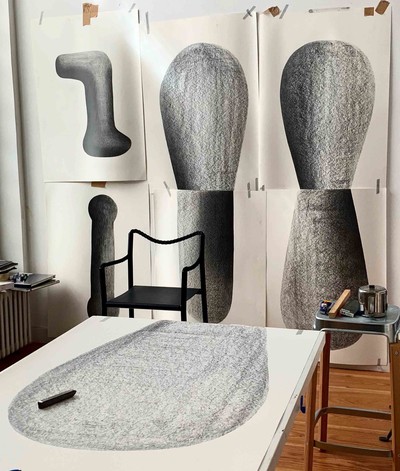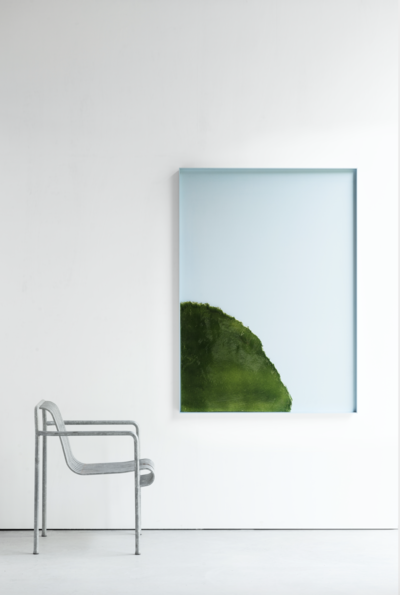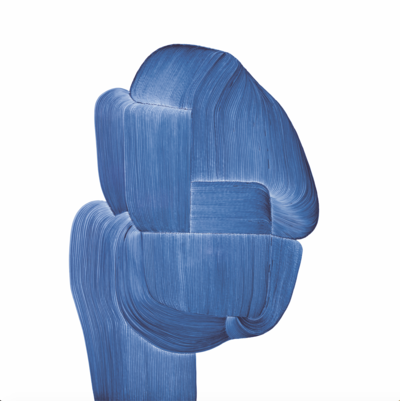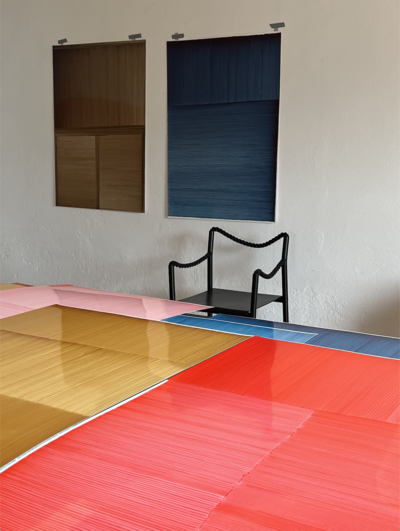“Daily Drawings” by Ronan Bouroullec
from 4 March to 29 April 2023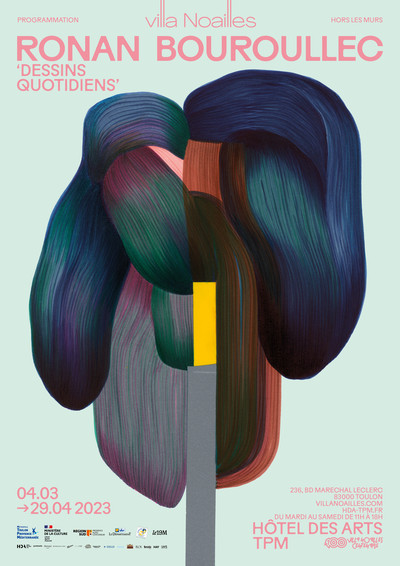
RONAN BOUROULLEC ‘ DAILY DRAWINGS’
EXHIBITION FROM
MARCH 4 TO APRIL 29, 2023
Exhibition open from Tuesday to Saturday from 11am to 6pm.
Closed on Sunday and Monday.
Free entrance
HÔTEL DES ARTS
CENTRE D’ART
TOULON PROVENCE MÉDITERRANÉE
236 BD MARÉCHAL LECLERC
83000 TOULON
Guided tours of the exhibition every Wednesday
and Saturday at 3 pm (free admission without reservation)
For more information on the activities offered
around the exhibition:
04 94 93 37 90 - www.hda-tpm.fr
The Hôtel des Arts TPM in Toulon is opening its doors to Ronan Bouroullec for the exhibition “Daily Drawings” showing from 4 March to 29 April 2023 as part of the Villa Noailles’ off-site programme.
Ronan Bouroullec has always drawn on a daily basis. He sees this purely artistic practice as being quite independent of the profession for which he is internationally renowned. Although there is a porosity between these two aspects of his work, which nourish one another, it is drawing that Ronan Bouroullec considers as essential to his equilibrium.
With almost 300 works (drawings, bas-reliefs and notebooks) on exhibition, he reveals a small part, as yet little known, of his creative talent. A tiny fraction in view of the many thousands of drawings, all preserved, but a sufficiently varied representation to cast light on this intensely private facet of the personality of one of the most talented French designers of his generation.
The exhibition will take the form of a triptych.
The first part of the exhibition will be shown at the Hôtel des Arts in Toulon, while the second part, entirely given over to Ronan Bouroullec’s ceramics, will be shown at the Galerie du Canon as part of Design Parade Toulon 2023. The third part will also be shown this summer, at the Villa Noailles as part of Design Parade Hyères. A return to roots for Ronan Bouroullec, as in 1997, one of the very first solo exhibitions of his nascent career as a designer was shown in Toulon at the Hôtel des Arts.
As part of his exhibition “Dessins Quotidiens” presented at the Hôtel des Arts TPM from March 4 to April 29, 2023, Ronan Bouroullec will hold a conference on Saturday, April 8, 2023 at the Camondo School, Maison de la Créativité, 1 Parvis des écoles 83000 Toulon.
Duration 2 hours - on registration only
150 places available
Nulla dies sine linea. Like Appelles, the painter described by Pliny the Elder, Ronan Bouroullec does not let a day go by without spending time drawing. A series of exhibitions – in 2011 at Arc en Rêve in Bordeaux, in 2013 at the Musée des Arts Décoratifs in Paris, as well as at the kreo and Giorgio Mastinu galleries – and books – such as Drawings (JRP Ringier, 2013), and the eight artist zines published by Nieves – has begun, over the last 10 years, to reveal the scale, depth and complexity of the long-secret universe that we can today recognize as a vital aspect of his work.
But it is only the beginning, because this vast body – 200 to 300 drawings every year – remains largely unpublished. Since the 1990s the drawings have been collected in countless sketchbooks and portfolios, stored in chronological order, with the aim of conserving everything – or almost everything – without classifying by type, theme, format or technique. The editing process happens – if it needs to happen – later, as part of a reflection on their publication. This desire to suspend ideas of choice and intention, to relegate the drawings to a time entirely unconnected with the moment of their creation, is part of the rigorous protocol that presides over Ronan Bouroullec’s drawings. A protocol marked by the question of absence of premeditation.
The absence of premeditation means firstly that there is no specific place for drawing: in the train, at home, in a hotel room, around the house, anywhere except the studio. Nor is there any specific moment: on a trip, at night, during the frozen time of the 2020 lockdown, summers in Brittany – long consecrated exclusively to drawing and surfing, disciplines that bring together the same movements of liberty and fluidity, but also the same solitary dimension. And no specific materials: paper picked out of off-cuts from the printer next door, pens old or new, dry or faded, whatever comes to hand determining the colours of the drawing and the texture of its lines. No plan or initial idea: the form unfolds progressively through repeated gestures, starting at the centre of the sheet and building up adjacently. Unlike a sketch, indispensable tool in the designer’s creative process, Ronan Bouroullec’s drawings are defined by the rejection of concerns with a problem, criteria or results, by a refusal to engage with any definition of the work: it is drawing without design.
The asserted absence of intention renders questions of subject or aesthetic inspiration of little relevance, as the impression of a relationship with form, the apparition of a figure that might be anthropomorphic (a heart, a head), organic (wood, feathers) or architectonic (a platform, a barrier), cannot be anything other than a chance encounter. This ‘automatic’ dimension is not so much a surrealist logic embracing the unconscious, but rather something approaching meditation, or the martial arts with their Zen philosophy, whereby, in the words of Emmanuel Carrère, “it is not a question of accomplishing a performance, but of instigating something within oneself”. In drawing as in Tai-chi, the abolition of intention is linked to the regularity of the exercise and to the absolute focus on gesture: in Ronan Bouroullec’s case, his (left) hand resting lightly on the paper, the movement of his body around the page, the pulse of the line, the rhythm of the drawing in synchronicity with his breathing.
It is around this notion of synchronicity that the opposition between time for drawing and time for designing clearly establishes itself. The latter is distended, stretching over a very long period, from initial idea to delivery, with pauses, steps backwards, lost time. It is the time for projects, for socializing, negotium. In contrast, drawing time is linear, continuous, in synchrony with the time as it is experienced. It is marked by immediacy, by the accord between the gesture and its result. It is the time for selfawareness, for spiritual exercise, otium.
But it is also a time for pleasure. Beyond any intention, satisfaction or finished result, the pleasure of gliding, more or less fluidly, more or less quickly, depending on the resistance of the paper and the viscosity of the ink. The pleasure of the slowness of a biro, of the speed of a felt-tip on coated paper, the liquid sensuality of watercolour pencils or brush pens. The pleasure of drawing evoked by Vasari about the young Michelangelo, who “spent as much time as he could [drawing] on the sly, which his elders scolded him for”. The pleasure in drawing, according to Jean-Luc Nancy’s formulation, whereby drawing is the place where, more than with any other artform, is found “the expression of the pleasure of wanting to give form and presence to that which goes beyond all presence and all form”.
Martin Béthenod
This text was published on the occasion of the exhibition “Ronan Bouroullec, ceramics, drawings,
bas-reliefs”, presented from April to June 2022 at the Giorgio Mastinu Gallery in Venice.
THE ROLE OF DRAWING
Drawing structures my life. The balance between periods of presence and of withdrawal, of fullness and emptiness, of work and of otium, is essential to me. The time spent away from the studio, when I’m in Brittany or travelling, needs to be filled by something, held together by something. And in those moments, I have drawing.
It’s always been there. Since my childhood, and the sense of solitude that occupied it. We lived in the country, I didn’t really have any neighbours or friends nearby.
Erwan is five years younger than me and at that age it is a big difference. My playmates were the wall, against which I kicked a ball, and the sheets of paper that I draw on endlessly.
Our family has a powerful work ethic, a horror of idleness. For my grandparents and my parents, it was inconceivable to spend time doing nothing. Reading wasn’t doing something, reading was for the evenings, but during the day you chopped wood, worked in the garden.
Drawing fell somewhere between the two: when I was drawing, they left me mostly in peace. Mostly, because my parents didn’t really understand what I was doing, but it was nevertheless acceptable. Drawing wasn’t really accomplishing anything, but at least it was an activity, something was happening. It’s never left me. Drawing is always present, in ways that change from year to year of course, but still there, like a companion, keeping me afloat, keeping me balanced.
DRAWING AND SKETCHING
There is no time in my life when I haven’t drawn in one way or another. Because there are two ways, two great continents of drawing. Two separate universes which, despite occasional interaction, contact and mutual influence, function in radically different ways. On one hand is the sketch drawing, which is subject to a project, serving its development. On the other is the free-standing drawing, which has no other function than to be what it is, finding meaning within itself.
At different times, sketching has occupied a more or less important role in my work process, thereby leaving more or less room for drawing. For a long time I needed to make endless sketches to check my ideas, finalise details. I spent my time drawing 200 versions of the same curve, the same connection, like a dancer rehearsing a single gesture over and over again to perfect a variation or posture. This is no longer the case. When I think about a form, I tend now to trace it in the air – sometimes I realise that I have been making absurd gestures walking along the street, people must think I’m crazy. While for a long time I needed to see the line on paper to visualise a project, today the gesture is enough for me. Like a composer who doesn’t need to play the piece he’s writing in order to hear it. I know almost instantaneously the height, the section or proportion. I know that it will be right, it’s almost physically ingrained in me. So the time that I no longer spend sketching, time now freed up, is entirely given to drawing without purpose.
WITHOUT PREMEDITATION
In drawing classes, I was often cited as the example of what not to do, as the one who went about it all the wrong way. When you learn to draw a landscape or an object, you generally start by laying out the principal lines, by outlining the overall picture, before going on to the details. I don’t work like that at all. When I draw a person, I start with the feet and work my way up to the head, without first building up a general idea. Something that every drawing teacher, from the most uninspiring to the most visionary, considers to be a real problem.
I always function like that, according to a process of development – by continuity and contiguity – of a form that originates in the detail. One year at the Arts Déco [École Nationale Supérieure des Arts Décoratifs, Paris], we had to do a chest of drawers; I spent nearly the whole term sculpting the knob that I wanted without for a moment thinking about the overall object. For me, the very sense of the project came from this detail, and from the sensual relationship that was established with it. Today, experience obviously enables me to see the bigger picture, to understand and anticipate many factors, but the question of detail remains essential in my work, as is that of the connection. Take this vase, or this chair, their overall form is obviously fine, but I think that the heart of my language is about they are assembled, how the forms, the planes, the materials, how things connect together.
Drawing also works like that. It starts at the centre of the page, generally, without anything being pre-defined, and it is the progressive development of the line that in the end produces a form that was not anticipated.
WHAT MAKES A SUCCESSFUL PROJECT?
The question of the atmosphere that objects or places emanate is almost more important to me than the things themselves. That almost magical effect, which can suddenly provoke an emotion when you walk into a room, onto a square, when you enter a chapel.
Some designers, including the best, those who I really admire, who I esteem or who are friends, consider their work to be inseparable from a quest for success, for the bestseller. This is perhaps a particularly French attitude, but for my own part, when a project does become a bestseller, I tend to think that there must be something wrong with it! More than questions of quantity or commercial success, what is important for me is the idea of dissemination.
A successful object is something that suddenly exists in people’s everyday lives. It is like a familiar song playing on the radio when you get into a taxi on the other side of the world. You’re
walking through Rome and come across a café full of chairs that you designed. On Instagram you see one of your posters in the bedroom of a teenager in Tokyo, or in Mexico. Coming out of a big exhibition of the Algues in MoMA, you walk in front of a sushi bar that has hung a few bits of the same Algues in their window, a bit haphazardly …
The joy of design is the multiple existences of things, far beyond the places where they are exhibited – places which I adore but that represent only a tiny fraction of space. It is the fact that objects don’t only exist within a closed structure, but that they have a kind of public existence, beyond anything imagined by their creator.
While with design it is almost selfevident to me when a project is complete, when it is a success, with drawing it is much less clear. I think that its value lies in the exercise itself, in what you could call praxis. In the same way, it is the notion of a dynamic whole, a creative flow that takes precedence over the way I look at each drawing, at least while I’m drawing it. All the completed drawings are kept, in chronological order. It is only later on, in preparation for an exhibition or a publication, that questions of choice and critical judgement come into play.
THE EXHIBITION IN TOULON
I have always designed my own exhibitions, avoiding an approach to my work that is overly analytical or academic. For this exhibition of drawings, even more than for an exhibition of objects, I didn’t want to step back or take an overview. Again the idea of flow: what is important to me is not so much to map it out as to dive into it, to follow the current, and to see what senses, what emotions are aroused by the experience.
So the Toulon exhibition was not constructed according to a master plan, but developed organically. With the help of my assistants Alex and Emi, I opened one after another of hundreds of notebooks and portfolios, starting with the most recent and working back in time. There was so much of it that it quickly became clear that we were going to have to give up any ideas of a complete retrospective. We therefore decided to focus the selection of drawings on those made over the last five years, a period during which my drawing activity has become increasingly clearly separate from my project work. In the use of loose sheets, for example, whereas previously sketches and drawings had co-existed quite naturally in the same notebooks. But above all by securing its own space – away from the studio, a place for projects and objects, but also from people – as well as its own time slots and a status in its own right, independent, within
my work.
This relatively narrow view, restricted in time, of the corpus of drawings is counterbalanced by the decision to present a very wide representation of the notebooks, from my very first to the most recent. This back-andforth between broad and narrow viewpoints reinforced the sensation of a long-established practice, to give it greater depth of field. The question of the exhibition design was a consideration from the start. I initially imagined a protocol for installation, a concept of structures to display the drawings. I designed several projects before putting all of it aside. I felt that it would have been a convenience, a way of reassuring myself with something I knew how to do. So the layout was constituted from the space as it was given to me, with a very simple repertoire of hanging options: walls, tables, platforms. It rhythmically, almost musically, articulates moments of density, that almost feel they’re overflowing, with moments of calm.
I wanted, for example, the first room to be a sort of summary, which would immediately give an idea of the coherence of my approach as a whole, through a wide range of formats and techniques, mixing tiny things, some almost pointillist, some very delicate biro drawings, with large felt pens or bas-reliefs. Then follows a series of sequences organised around similar forms, atmospheres and even feelings, when the drawing becomes the seismogram of the artist’s psyche. And finally, in the last room, the
sensation of profusion and of a flow of energy. The whole thing is punctuated, rythmed, by the presentation of the notebooks. Obviously only a single double-page spread of each can be presented, but little films show them being leafed through from cover to cover. What might have been a cause of frustration actually reinforces the dynamic, cinematic character. Similarly, the effects of the transparency of the pages (you can make out the drawing on the verso) and of the volume of the notebooks (the edges of the drawings join on the fore-edge of the pages)
accentuate a certain enigmatic dimension.
Interview by Martin Béthenod, January 2, 2023
Ronan Bouroullec is a French designer born in Quimper (Brittany) in 1971.
He went to the École Nationale Supérieure des Arts Appliqués et des Métiers d’Art when he was 17. The following year he exhibited for the first time at the Salon du Meuble in Paris. This determined the beginning of his collaboration with French design companies, with numerous design projects during his student days given precedence over his college work. He continued his studies at the École Nationale Supérieure des Arts Décoratifs. In 1996, his Vase Soliflore took its place in the Centre Pompidou’s permanent collection. In 1997, the Néotù gallery gave him his first solo exhibition with Vase Combinatoires. Giulio Cappellini noticed his work at the Paris Salon du Meuble, giving him the opportunity to create his first pieces of industrial design, and he was awarded the Grand Prix du Design by the City of Paris.
In 1998 he was joined by his brother Erwan. In 1999, Ronan Bouroullec was awarded the New Designer Award by the International Contemporary Furniture Fair in New York. Ronan and Erwan Bouroullec’s subsequent meeting with Rolf Felhbaum, then head of Vitra, was to mark the beginning of their ongoing partnership, and to instigate others with international design companies such as Flos, Hay, Magis, Mutina, etc.
Their designs span from craftsmanship to mass production, via permanent public space installations around the world.
They have been the subject of several monographic exhibitions, including at the Design Museum (London, 2002), the Museum of Contemporary Art – MOCA (Los Angeles, 2004), the Centre Pompidou–Metz (2011), the Museum of Contemporary Art Chicago (2012), and the Musée des Arts Décoratifs (Paris, 2013). The Philadelphia Museum of Art recently showed a retrospective of their work.
Their designs are represented in the collections of the most important international institutions, including MoMA New York, the Victoria and Albert Museum in London, the Art Institute of Chicago, and the Musée des Arts Décoratifs in Paris.
Alongside his work as a designer, drawing – which has been a regular activity since early childhood – occupies an important place in Ronan Bouroullec’s daily life.
Over the last few years, his drawings have been introduced into large public and private collections around the world, including those of the Art Institute of Chicago, Cooper-Hewitt, Smithsonian Design Museum. His works have been presented in a range of contexts and places around the world: Giorgio Mastinu Fine Art Gallery (Venice, 2018 and 2022), Galerie kreo (Paris, 2019 and 2022, London, 2021), Licht Gallery (Tokyo, 2021), Casa Mutina (Modena, 2021).
His drawings have also been exhibited as part of group exhibitions, including at MAK–Museum of Applied Arts (Vienna, 2019), Vitra Design Museum (Weil am Rhein, 2019), Caixa Forum (Barcelona, 2020, Madrid, 2020) and at the Musée des Arts Décoratifs (Paris, 2021).
Drawings have also occupied an important position in monographic exhibitions of the work of Ronan and Erwan Bouroullec, notably:
- Album, Arc en Rêve (Bordeaux, 2011), Vitra Design Museum (Weil am Rhein, 2012), Philbrook Museum of Art (Tulsa, 2014);
- Bivouac, Centre Pompidou–Metz (2011), Museum of Contemporary Art (Chicago, 2012)
- Momentané, Musée des Arts Décoratifs (Paris, 2013).
The drawings have also been the subject of publications:
In 2013, Drawing, published by JRP Ringier, showed drawings made by Ronan and Erwan between 2005 and 2012. Between 2018 and 2021, five works were published by Nieves: Drawings (2018), Ronan Bouroullec 18 (2019), Crayon-Pinceau (2020), Janvier (2021), Stylo-Bille (2021).
In 2021, a monograph was published to accompany the exhibition at Mutina: Ronan Bouroullec – The Sound of My Left Hand. In 2023, Phaidon will publish Day After Day, a major work imagined as a personal journal covering more than a decade.
Ronan Bouroullec is represented by Galerie kreo, in Paris and London, and by Giorgio Mastinu Fine Art Gallery, in Venice, for his original drawings. Limited and non limited editions are distributed by The WrongShop.
